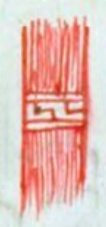tzontli (Chav1)
This detail of the simplex glyph for the noun tzontli shows a bundle of what may be sticks, painted red. They are bound around the middle with a white belt with a step design.
Stephanie Wood
Four hundred, of course, is a vigesimal quantity, and the Nahuas had a vigesimal (root of 20) numerical system. A gloss on another example of tzontli (a case of 10 tzontli, or 4,000) refers to the items as "ramitos" (little branches). Likewise, a century ago, 400 small pieces of firewood were bundled in what was called a tzontle, a Nahuatl loan in Spanish. (See: Paul Carpenter Standley, Trees and Shrubs of Mexico - Part 1, 1926, 806.) This may support the reading that this numeration called a tzontli could have a visual association with branches or trees. Some signs for tzontli do look like the laurel or pine branches (acxoyatl) that were part of religious rituals. Nigel Davies (Human Sacrifice, 1981, 218), in fact, called a tzontli sign a "fir tree." Zelia Nuttall (in a volume of anthropological papers called Boas Anniversary Volume, published by Berthold Laufer in 1906, 296) refers to the bundles of 400 as containing either "sticks" or "hair." Some of the tzontli glyphs across this collection, such as the example here, do look like upright bundles of sticks that are bound around the middle. A binding like the one on this glyph above also appears in the Matrícula de Huexotzinco in a glyph for Tzompan, below.
Another common visual associated with the word tzontli involves large locks of hair or even strings of hair from the head. "Hair" is often the translation for tzontli into English. This word for hair and the word for 400 would therefore serve as homonyms. Similarly, speaking of 400 tzontles, four hundred corn cobs (Calixta Guiteras Holmes, Perils of the Soul, 1961, 47), is another case where the tzontli is simply a numeration and does not reflect upon the object being counted. So, the conclusion is that a sign for 400, like all of them, whether branches, sticks, or hair, will have the role of a phonogram.
1578
Jeff Haskett-Wood

tzon(tli), hair, https://nahuatl.wired-humanities.org/content/tzontli
-tzon(tli), when preceded by a number, multiples of four hundred, https://nahuatl.wired-humanities.org/content/tzontli-0
The Codex Chavero of Huexotzinco (or Códice Chavero de Huexotzinco), https://www.loc.gov/resource/gdcwdl.wdl_03246_001/?sp=1
The Codex Chavero of Huexotzinco (or Códice Chavero de Huexotzinco) is held by the Instituto Nacional de Antropología e Historia, México. It is published online by the World Digital Library and the Library of Congress, which is “unaware of any copyright or other restrictions in the World Digital Library Collection.”
